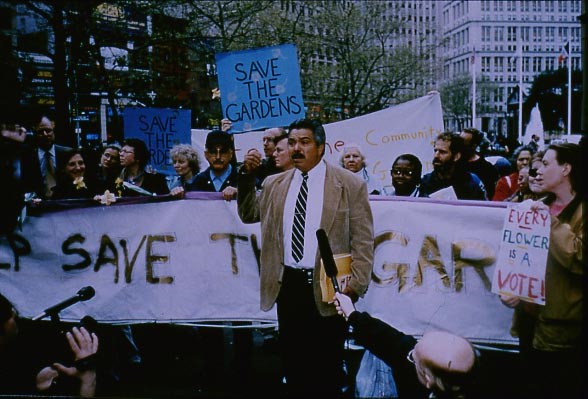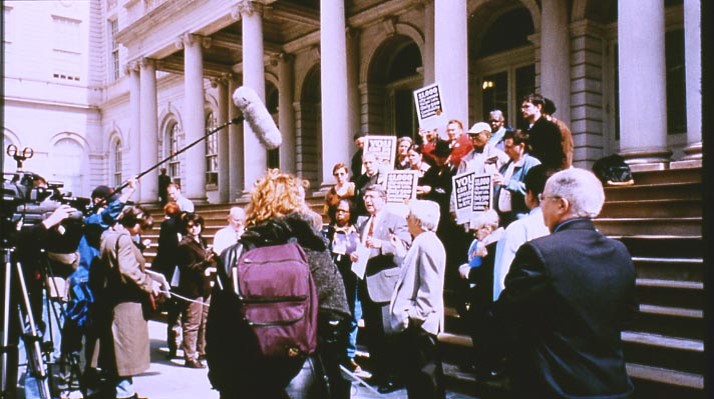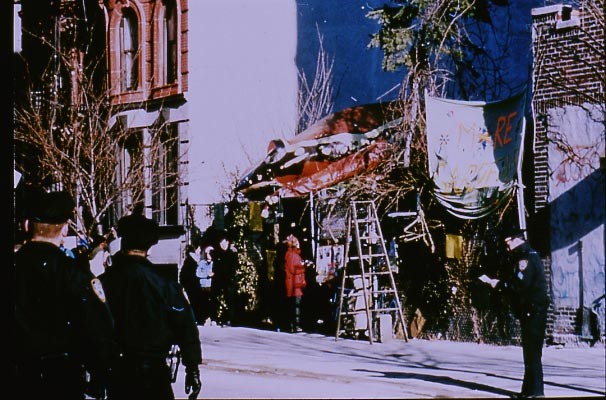100 Gardens - Protests of the 1999 Garden Auction
NYC's community gardens haven't always been so idyllic!
Many of New York City’s community gardens got their start in the 1970s as residents, in an effort to revitalize their neighborhoods, began to reclaim vacant and trash-filled lots and turn them into beautiful, safe, fresh food producing community centers. These lots, however, were owned by the city, and despite the decades of work that went into them, in May of 1999 Mayor Giuliani decided to put more than 100 community gardens up for auction to build affordable housing.
Gardeners were outraged. Community members came together with nonprofits and land trust organizations, some of them newly formed to combat this issue, to bring lawsuits against the city and organize protests, parades, and acts of nonviolent disobedience.

As Jane Weissman, Director of GreenThumb from 1984-1998 put it, “For 20 years prior, when funding for housing development was not available, community gardens flourished, beautifying, stabilizing, and revitalizing their neighborhoods. And yet, the city is willing to sacrifice these gardens without holding any kind of formal review.”

In November of 1999, the cherished 22 year old Esperanza Garden in the East Village was threatened with development. As the case was being argued in court, protesters occupied the garden space around the clock for months to protect it from destruction. They stood sentry overnight in a large coqui frog sculpture (a Puerto Rican symbol to ward off foes). In February of 2000, things came to a head. More than 100 protesters came to the garden to demonstrate, chaining themselves to concrete blocks and fence posts and chanting songs. The police broke their way through, arrested 31 protestors, and in 15 minutes the bulldozer had completely destroyed the garden.

During the destruction, Attorney General Eliot Spitzer successfully procured a restraining order against the city to protect the gardens up for auction, but it came too late to save Esperanza. Spitzer argued that the lots should be considered parks, which can only be sold after an environmental review or by the state legislature’s approval.
While not all of NYC’s community gardens were spared, the protests brought international and national attention to their value, and many were saved. The day before the auction of the remaining 114 community gardens, the Trust for Public Land and the New York Restoration Project bought them, saving them from destruction. In 2002, Mayor Bloomberg and Attorney General Spitzer negotiated the Community Gardens Agreement, preserving an additional 198 gardens, subjecting 110 to review before development, and sentencing 38 to development.
----------------
This fall GrowNYC will build its 100th community garden. To celebrate, we are sharing stories from GrowNYC gardening history!
But these stories are far from over…
You can help ensure that all New Yorkers have access to green space by making a donation today to GrowNYC's New Garden Fund.
Recent Posts
- GrowNYC Publishes 2023 Impact Report
- 2024 Seasonal Greenmarkets and Farmstands Opening!
- GrowNYC's 2024 Plant Sale
- Use Pandemic EBT (P-EBT) with GrowNYC
- The 2024 Health Bucks are now available!
- Sign Our Petition: Save Community Composting
- 2023 Holiday Schedule - Greenmarkets, Farmstands, Food Scrap and Clothing Collections
- Deck the Halls - 2023 Greenmarket Gift Guide & Christmas Trees + Holiday Wreaths at Greenmarkets
- GrowNYC Weather & Site Closures
- Thanksgiving Week Schedule 2023 - Greenmarkets, Farmstands, Compost
Tags
- Grains
- compost
- recycle
- recycling
- greenmarket
- kids
- union square
- swap
- youthmarket
- grow to learn
- learn it grow it eat it
- reuse
Archives
- April 2024 (1)
- March 2024 (2)
- February 2024 (1)
- December 2023 (1)
- November 2023 (3)
- October 2023 (5)
- May 2023 (1)
- April 2023 (2)
- December 2022 (1)
- November 2022 (3)
- September 2022 (1)
- June 2022 (1)
- April 2022 (2)
- March 2022 (2)
- December 2021 (2)
- November 2021 (1)
- October 2021 (3)
- September 2021 (3)
- August 2021 (2)
- June 2021 (3)
- May 2021 (1)
- April 2021 (1)
- March 2021 (1)
- January 2021 (8)
- December 2020 (2)
- October 2020 (3)
- July 2020 (1)
- June 2020 (2)
- March 2020 (6)
- February 2020 (3)
- January 2020 (2)
- December 2019 (2)
- November 2019 (1)
- October 2019 (1)
- September 2019 (7)
- July 2019 (4)
- June 2019 (1)
- May 2019 (1)
- April 2019 (3)
- March 2019 (4)
- February 2019 (3)
- January 2019 (3)
- November 2018 (3)
- October 2018 (3)
- September 2018 (1)
- August 2018 (2)
- July 2018 (4)
- June 2018 (5)
- May 2018 (1)
- April 2018 (1)
- February 2018 (3)
- December 2017 (2)
- November 2017 (3)
- October 2017 (7)
- September 2017 (4)
- August 2017 (3)
- July 2017 (1)
- June 2017 (2)
- May 2017 (4)
- April 2017 (1)
- March 2017 (2)
- February 2017 (2)
- January 2017 (3)
- November 2016 (1)
- August 2016 (1)
- July 2016 (4)
- April 2016 (2)
- March 2016 (4)
- February 2016 (2)
- January 2016 (1)
- December 2015 (4)
- November 2015 (2)
- October 2015 (2)
- September 2015 (4)
- August 2015 (2)
- July 2015 (2)
- June 2015 (3)
- May 2015 (2)
- April 2015 (2)
- March 2015 (1)
- February 2015 (2)
- January 2015 (2)
- December 2014 (3)
- November 2014 (5)
- October 2014 (3)
- September 2014 (3)
- August 2014 (3)
- July 2014 (3)
- June 2014 (2)
- May 2014 (5)
- April 2014 (4)
- March 2014 (2)
- February 2014 (3)
- January 2014 (1)
- December 2013 (4)
- November 2013 (3)
- October 2013 (5)
- September 2013 (4)
- August 2013 (2)
- July 2013 (4)
- June 2013 (2)
- March 2013 (2)
- February 2013 (2)
- January 2013 (2)
- December 2012 (3)
- November 2012 (2)
- October 2012 (3)
- September 2012 (2)
- August 2012 (5)
- July 2012 (4)
- June 2012 (3)
- May 2012 (2)
- April 2012 (4)
- March 2012 (7)
- February 2012 (5)
- January 2012 (9)
- November 2011 (7)
- October 2011 (4)
- September 2011 (2)
- August 2011 (7)
- July 2011 (4)
- June 2011 (2)
- May 2011 (4)
- April 2011 (3)
- March 2011 (5)
- February 2011 (3)
- January 2011 (5)
- December 2010 (5)
- November 2010 (7)
- October 2010 (6)
- August 2010 (1)
- June 2009 (1)
- May 2009 (1)
- March 2009 (1)
- November 2008 (2)
- August 2008 (1)






